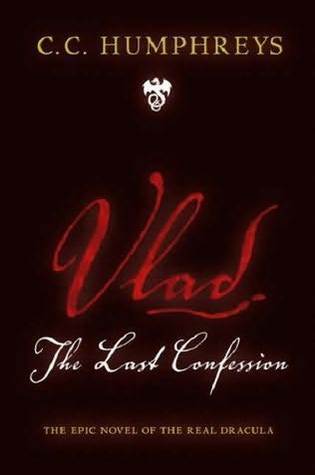Review: Vlad The Last Confession by C.C. Humphreys

Vlad: The Last Confession by C.C. Humphreys is a historical fiction account of 15th century Vlad Dracula, Prince of Wallachia–or as most know him, Vlad the Impaler. The tale is framed by confessionals told in 1481 from those closest to Vlad, his former lover, his best friend, his confessor, who witnessed his lows and highs many years before. Humphreys then takes us to Vlad’s adolescence as a hostage in Turkey, very much under the yoke of the Sultan Murad and his son, Mehmet. Vlad, his younger brother Radu, and Vlad’s best friend Ion navigate the challenges of the Sultan’s court as students and outsiders, always at odds with their “hosts.”
Vlad’s time as a hostage at the Sultan’s court is only the start of his miseries, which are compounded when he frees a young woman, Ilona, from a life of serving as a harem mistress. Ilona, who I believe is a fabrication of the author and not based on a real historical figure (?), then flees to Wallachia to await “her Prince” for whenever he is able to escape the Sultan. While Radu is taken to, for lack of a better word, be groomed by Mehmet, Vlad is thrown into the dungeons of Tokat as punishment for freeing Ilona. It is within the walls of Tokat that Vlad is forced into a sort of “training” in the art of torture and pain. While he is resistant at first and highly disturbed by the torture methods, especially the impalement, his traumas slowly engulf him.
When Vlad does make it back to Wallachia, and to Ilona, he is a changed man. No longer the youth full of hope and idealism, but a traumatized and broken man. What I really appreciated about Humphreys’ take on Vlad is that he wasn’t just “evil” for evil’s sake with no reason. Rather, Humphreys crafts a complex psyche heavily impacted by what I interpreted as PTSD, to account for Vlad’s violent and harsh behaviors. He is the monster they–the warring boyars and kings and sultans and torturers–made him. He is trauma manifest.
Due to his complex psychological state, I vacillated on my views regarding his relationship with Ilona. While at times she was his one true love, his only refuge of honesty and peace, Ilona seemed to always view him with caution. While he was also her true love, she also recognized the darkness within him–the line he always seemed to be walking. She was also well aware of him sleeping around, which was a little hard for me to understand. As such, she handled him with the cautious reverence Vlad himself had for his beloved trained goshawks. While this dynamic was clearly not healthy, Ilona loved him no matter what–even to her own ruin.
Readers will find no vampires or magic here, but a brutal and gory account of the tumultuous life of this 15th century Prince of Wallachia. Humphreys even offers real world explanations for Vlad’s supposed longevity from which legends grew. And in the end, we find Vlad’s masterful machinations work to his favor.



